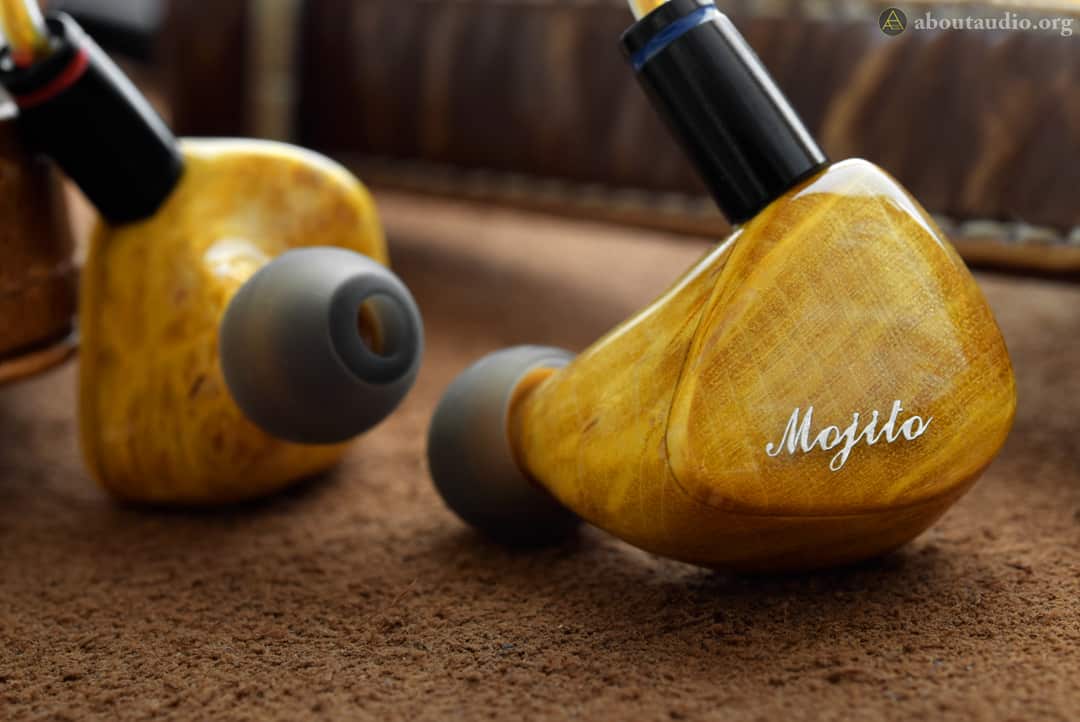 QOA Mojito Review – Aural breeze
QOA Mojito Review – Aural breeze
QOA (Queen of Audio) is a sister brand of Kinera that started off with a blast, succeeding Pink Lady as their first product. And if you did not know already, QOA is a literal “sister brand” as the two sisters, Sophie and Youko, that founded QOA are actual siblings with the founder of Kinera. So QOA well proved their ability in creating a quality IEM for a budget price, then what if we set the bar higher, something closer to a premium level IEM? With a price tag of $399, Mojito is the second product that QOA has to present to us today. Let us now take a look and see how it performs for its price as well as comparing with Pink Lady.
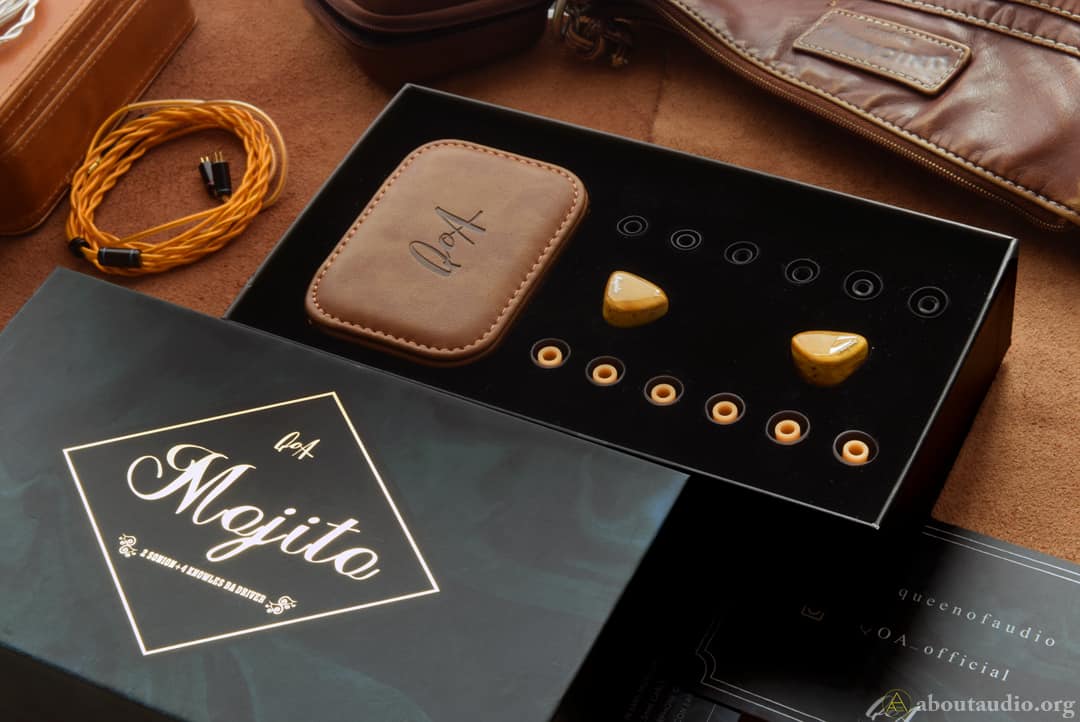 Packaging
Packaging
Mojito comes in a paint-syle box design. With a dark green background covering all sides of the box, it is decorated with gold highlights on front and back. On the back, it contains the specifications as well as the frequency response graph. A small sticker is attached to the side of the box to indicate the color options. Other than the earpieces, it includes a 3.5mm stock cable, a leather case, 3 pairs of normal silicone eartips, 3 pairs of AET07-style eartips, a velcro tie, and some paperwork. Now while I personally do not use foam tips, having them would have certainly made a better packaging.
The included accessories themselves are of good quality. AET07-style eartips are just as good as the ones from Acoustune and deliver better clarity compared to the traditional eartips. These tips are also made to be matched in color with the earpieces, giving a more consistent look to it. The leather case is very well made – it smells nice, feels nice, and built nice. There’s a thicker layer of cushion on the top of the lid as well as some protection padding on the inner side of the case.
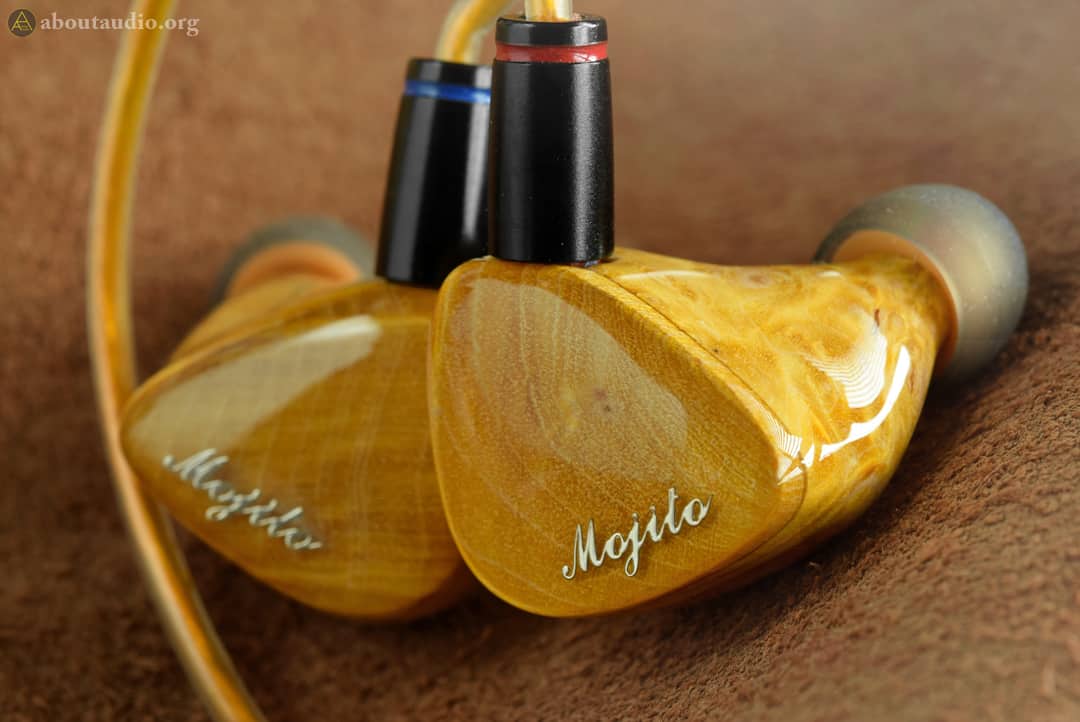 Earpieces
Earpieces
Mojito comes in three color options, which are Aqua Blue, Amber Orange, and Grape Sparkling Wine. The housing is fully made of stabilized wood and gives a rich, unique look to each and every piece, which are then coated with resin. Mojito uses 4-way 6BA drivers, comprised of 2 Sonion Drivers and 4 Knowles drivers. I’m a great fan of Sonion drivers and it sparks my interest even more if both Sonion and Knowles drivers are used altogether. That being said, it brings back memory when I reviewed Kinera Odin before, which uses a combo of 4 Sonion + 4 Knowles drivers.
The earpiece size is on a bit of a larger side but has no irritating shapes or edges and snugs into the ears without a hassle. The nozzle length is about average with each of the nozzle bores are separated into 4 tubes for a cleaner, and clearer, sound transmission. The cable connectors are terminated in 0.78mm CIEM 2pin which is one of the standard connectors as of now. The 2pin sockets are not non-recessed but slightly recessed, which makes it compatible with either cable types.
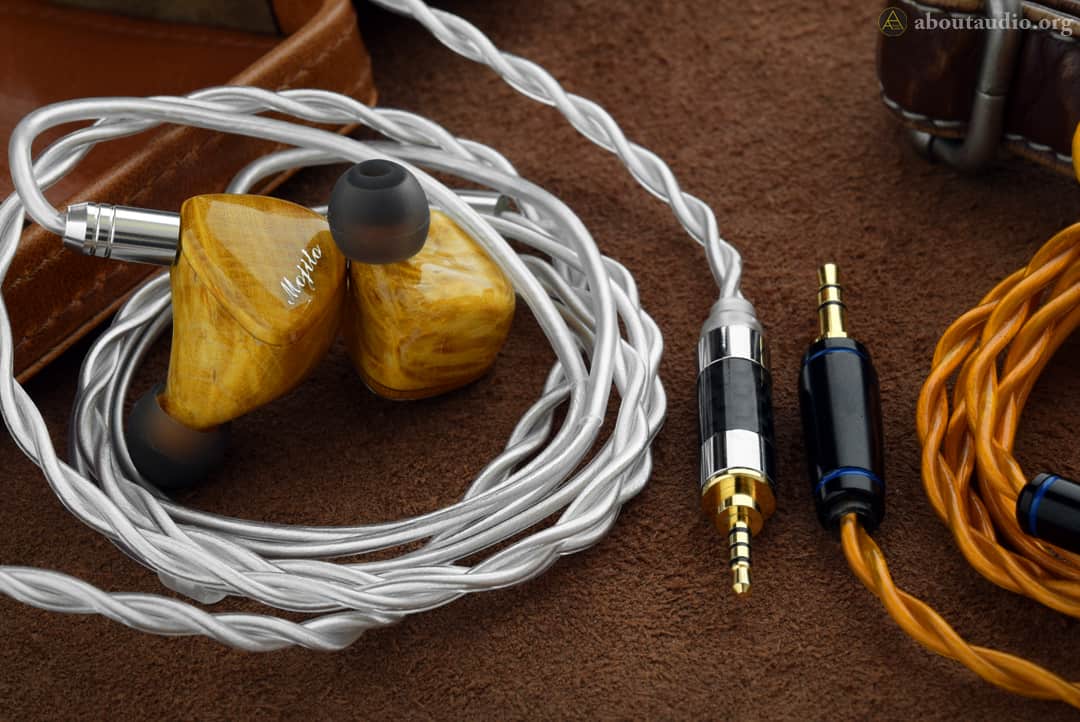 Cable
Cable
In case the color matching on the eartip was just not enough, QOA also matched their colors on the cable too. The stock cable is made of 2-braided Furukawa silver-plated OCC wires. Keep in mind that the 2pin connectors are optimized for Mojito’s “slightly” recessed 2pin sockets, so you may not be able to use these cables for IEMs with fully recessed 2pin sockets. The splitter, connector, and the plug are all made with solid parts and feels sturdy to the touch. While the stock cable only comes in 3.5mm termination, options for 2.5mm and 4.4mm appear to be available by making a separate purchase which has the same type of wire as the stock one but instead with plain silver color.
 Sound impression – Lows
Sound impression – Lows
Having the music thoroughly balanced, Mojito draws a sound signature that sits between flat and mild w-shape where lows, mids, and highs are all slightly boosted from being flat. Lows are evenly emphasized across the bass region and slightly pulled forward, keeping a flat bassline while holding onto the dynamics. This results in a bass response that is calm but also fun. It retains good density, speed, and power when striking a punch that follows up a clean and full-bodied decay that is highlighted just to the right amount. Depth and extension for the ultra lows are decent considering its reference tuning, consisting of a thick presentation in both color and thickness.
Lows, in general, keep a plain stance but are thoroughly seasoned in tonality, doing a fine job bringing out the details and richness. The colors here are relatively much darker compared to the upper range, leastways assisting the bass to stand out clearly with a bigger contrast. The upper bass gradually fades into the mids which helps the sound to maintain its linearity in distance. I like the way how Mojito finishes its bass in a subdued, lively manner that well respects the liveliness, despite it being rather light in overall bass quantity. Surely not meant for bassheads, but if you have a mild taste or often find the boomy bass rather unpleasant, the style of bass from Mojito should be right up your alley.
 Sound impression – Mids
Sound impression – Mids
The sound may be flat but not gone flat. Mids are Hi-Fi focused with much transparency and analyticity but not thrown away with the musicality, having the vocals possess an adequate amount of moisture and emo. The thickness of the vocals is on the thinner side – or should I rather call it “unbloated” since it does not miss out on the core density. It is a tad thin from the neutral timbre, but still intact to the accuracy. We could say mids here somewhat resemble the way how Noble Audio Kaiser Encore or Katana produce their vocals. For a quick comparison before moving on, although Mojito is on the flatter/mildly brighter side, mids are still warmer and comfier compare to the Nobles.
It is common to think full-BA IEMs with a flat signature would sound rigid or metallic, Mojito’s emo attitude naturally connects the dips between the BA drivers with a light amount of reverbs. This acts as adding a bit more meat to the frame (or structure) of the sound, giving the vocals that raw, blatant feeling without making it harsh or dry. Vocals flow stably and well leveled without audible dips, spikes, or sibilances. Overall I enjoy Mojito’s plain but sweet vocals where it clearly displays its refined grains and textures, taking an organic approach towards a flat signature. A generous amount of air is applied to the vocals, giving a mild open-field and cool-breeze presentation without tilting the temperature too cold.
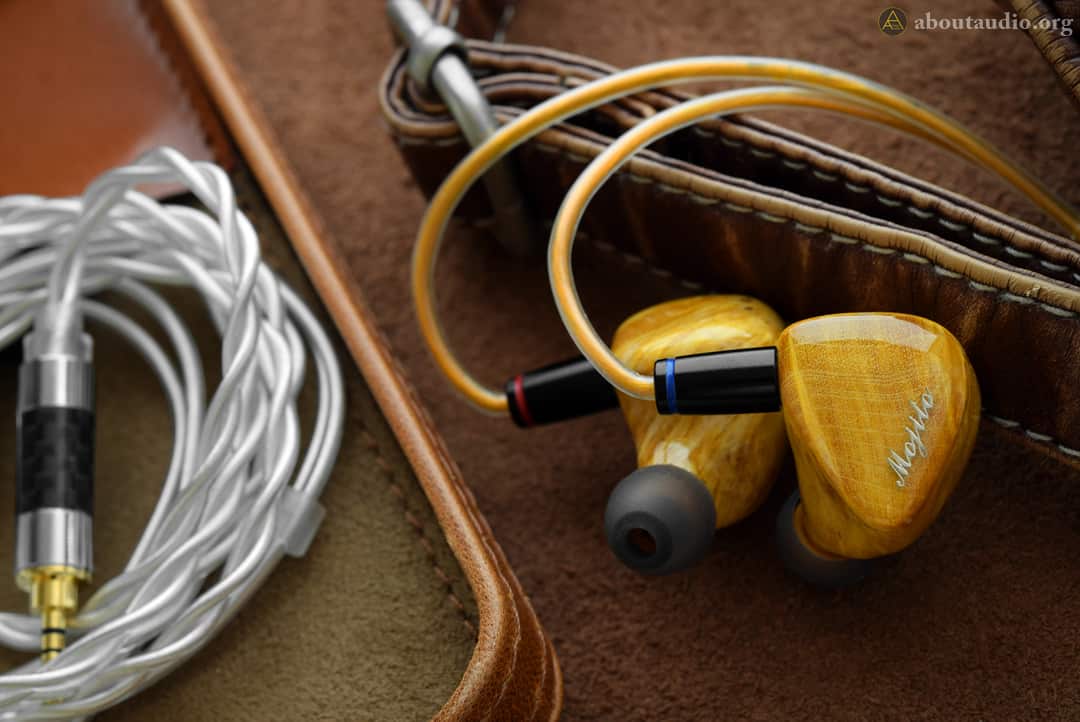 Sound impression – Highs, etc.
Sound impression – Highs, etc.
Highs take a small step back from the mids with a slight reduction in quantity. The tone is pure and transparent as water which lives up perfectly with its reference-style signature, just as intended. Highs pose a similar posture as mids did – unexaggerated, clean, and firm. Mojito does not highlight much on the spatial aspect of the treble instruments, keeping it linear and loyal to the original image positioning. Highs condense firmly with high density, then to be followed with a light and soft decay that gives a strong sense of airiness – resulting in a crisp, solid texture but not stiffening up in rigidity or hardness. The strikes are soft but not dull and are precise in expression.
The layerings for both mids and highs are very nice, showing clear divisions between each layer of sound. Overall, its sound is a tad dependent on different types of tracks and genres. For tracks that are intensively highlighted with sibilance or treble to their nature could cause Mojito’s upper range to get hot, but for most other cases Mojito simply oozes with a delightful amount of transparency and airiness. The included AET07-style eartips are ideal for maximum air and transparency, yet it is prone to lighter bass and hotter upper ranges, so I would suggest to also test out eartips with a longer and tighter stem such as AET08 or the other set of eartips that are included as an accessory.
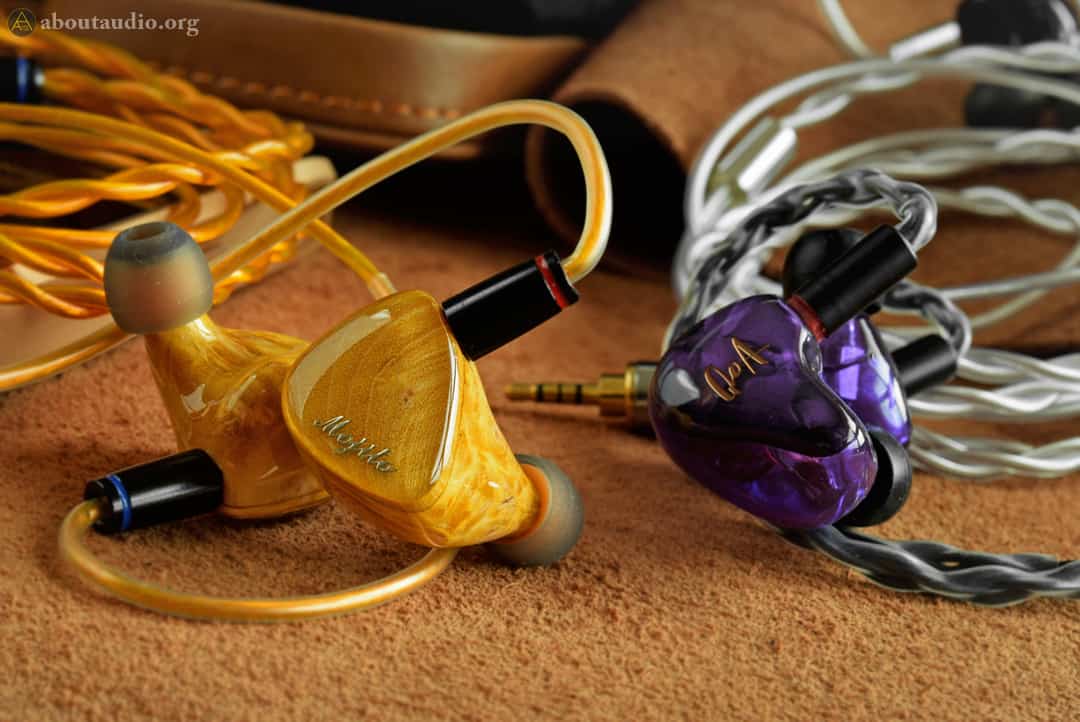 Comparisons
Comparisons
QOA Pink Lady (2BA+1DD) – While Pink Lady is not in the same price range as Mojito, it would still be a good point to start this comparison as it is the first and previous model that QOA produced. Pink Lady has a bass-driven, warm-tone sound signature whereas Mojito shows a linear, bright sound. The upper ranges on Pink Lady are stuffy and muffled relative to Mojito. The upper ranges on Mojito are significantly better in transparency and airiness.
Mids also carry a greater amount of airiness, creating an open-field sound that the sound stage is mostly created by mids and highs, while the sound stage for Pink Lady is mostly done by lows and mids. The texture details, especially for the vocals, are a lot more blatant and expressive on Mojito. The performance is superior on Mojito as we overall look at the big picture, though these two are nearly the opposite in sound signature (musical and bassy for Pink Lady, analytical and near flat for Mojito) so keep that in mind.
Moondrop Blessing 2 (4BA+1DD)– Blessing 2 is similar enough to Mojito in sound signature, even to the point where I could call them as brothers since both sounds fresh, relieving, and considerably flat – though there are still some noticeable differences in characteristics. Mojito is more active and aggressive in expressing the liveliness and texture grains while Blessing 2 is calmer and flatter.
Mojito brings out slightly more bass quantity but not to a day and night degree. It gives a bass that is deeper and darker in color too. Trebles are also brighter, stronger, and more expansive on Mojito, bringing better realism but Blessing 2 would be a bit less provocative, if for lengthy listening sessions. Snare drums and treble instruments deliver stronger and faster strikes, enhancing the taste and that “hitting” sense.
BGVP DM7 (6BA) – These two are different but also sort of similar as we look at the big picture – not because they share the same BA numbers, but also in their overall sound signature. Both do an equally good job in digging out the bass depth and that pitch-blackness, but DM7 with slightly more bass quantity and warmth. Mojito shows its superiority in layering, making clearer and finer slitters of layers within its soundstage. This also leads to better separation as well, but nothing big in difference.
Plus, Mojito still keeps the sound in good consistency, not flying all over the place. On the other hand, DM7 achieves slightly more density and delivers nicely condensed strikes. Headroom size is on the same if not similar level. Another significant difference is that the background of DM7 is based on black while Mojito is white, so DM7 focuses on the deep, cozy feeling towards the lower ends, and Mojito is for the open-field and ventilated headroom towards the top – like an open ending of a story.
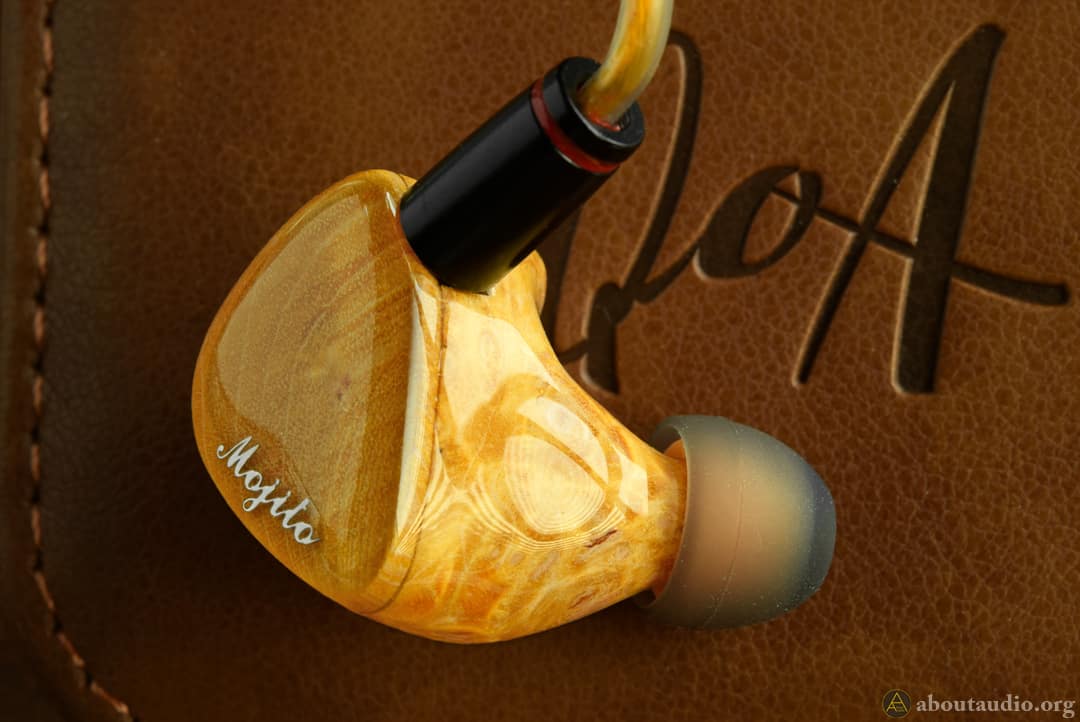 Verdicts
Verdicts
Mojito reaffirms its position as a higher rank model by stepping up the game with improved analyticity, resolution, and linearity, making it an ideal selection for those looking for a neutral, reference tuning. It would also be a very good alternative if you are looking for a flat sound signature but also do not want to miss out on a decent amount of dynamics and musicality.
The major charm of Mojito could be summarized in one sentence that it “presents the music with impact and vividity, even while maintaining a flat sound”. I would also suggest my fellow audiophiles take note of Mojito and QOA as I believe this level of sound quality definitely deserves good attention like Moodrop Blessing 2 does. Would like to give a nice pat on QOA’s shoulder and much looking forward to their future activities. Well done, QOA!
RELATED REVIEWS
Thanks to QOA for providing Mojito in exchange for an honest impression/feedback.
I am not affiliated with QOA and none of my words were modded or asked to be changed.


